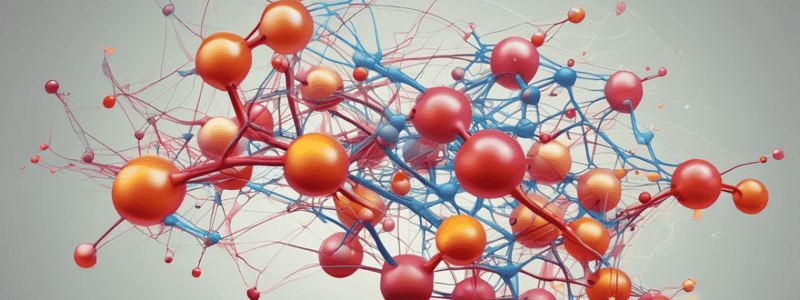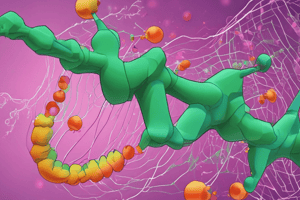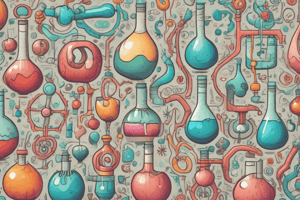Podcast
Questions and Answers
What is the direction of numbering carbons in the alternative convention for polyunsaturated fatty acids?
What is the direction of numbering carbons in the alternative convention for polyunsaturated fatty acids?
- From the omega carbon to the alpha carbon
- From the methyl group to the carboxyl group (correct)
- From the alpha carbon to the omega carbon
- From the carboxyl group to the methyl group
Which of the following omega-3 fatty acids can be synthesized from ALA?
Which of the following omega-3 fatty acids can be synthesized from ALA?
- Only DHA
- Both DHA and EPA (correct)
- Only EPA
- Neither DHA nor EPA
What is the notation for Palmitoleic acid, a C16 mono-unsaturated fatty acid?
What is the notation for Palmitoleic acid, a C16 mono-unsaturated fatty acid?
- 16:1(D8)
- 16:1(D9) (correct)
- 16:2(D9,12)
- 16:0
What is the name of the omega-3 fatty acid found in soybeans and flaxseeds?
What is the name of the omega-3 fatty acid found in soybeans and flaxseeds?
What is the function of the ω notation in the alternative convention for polyunsaturated fatty acids?
What is the function of the ω notation in the alternative convention for polyunsaturated fatty acids?
What is the primary function of bile acids in the intestine?
What is the primary function of bile acids in the intestine?
What is the main difference between sterols and steroid hormones?
What is the main difference between sterols and steroid hormones?
What is the role of cholesterol in the plasma membrane?
What is the role of cholesterol in the plasma membrane?
What is the source of cholesterol in mammals?
What is the source of cholesterol in mammals?
What is the primary role of steroid hormones in the body?
What is the primary role of steroid hormones in the body?
What is the primary function of lipids in storing energy?
What is the primary function of lipids in storing energy?
What is the characteristic of the double bonds in natural unsaturated fatty acids?
What is the characteristic of the double bonds in natural unsaturated fatty acids?
What is the role of vitamin K in biological functions of lipids?
What is the role of vitamin K in biological functions of lipids?
What is the characteristic of the hydrocarbon chain in fatty acids?
What is the characteristic of the hydrocarbon chain in fatty acids?
What is the significance of the hydrophobic nature of lipids in biological functions?
What is the significance of the hydrophobic nature of lipids in biological functions?
What is the common range of carbon atoms in natural fatty acids?
What is the common range of carbon atoms in natural fatty acids?
What is the primary function of eicosanoids in the body?
What is the primary function of eicosanoids in the body?
Which of the following hormones is NOT synthesized in the adrenal gland?
Which of the following hormones is NOT synthesized in the adrenal gland?
What is the enzyme inhibited by nonsteroidal anti-inflammatory drugs (NSAIDs)?
What is the enzyme inhibited by nonsteroidal anti-inflammatory drugs (NSAIDs)?
What is the role of prostaglandins and thromboxanes in the body?
What is the role of prostaglandins and thromboxanes in the body?
What is the primary source of estradiol in the body?
What is the primary source of estradiol in the body?
What is the function of prednisone and prednisolone?
What is the function of prednisone and prednisolone?
What is the result of the photochemical reactions in the rhodopsin molecule when it is excited by visible light?
What is the result of the photochemical reactions in the rhodopsin molecule when it is excited by visible light?
What is the primary function of Vitamin E in the body?
What is the primary function of Vitamin E in the body?
What is the role of Vitamin K1 in the body?
What is the role of Vitamin K1 in the body?
What is the result of the transformation of the rhodopsin molecule in the rod cell of the vertebrate retina?
What is the result of the transformation of the rhodopsin molecule in the rod cell of the vertebrate retina?
What is the result of the conversion of 11-cis-retinal to all-trans-retinal in the rhodopsin molecule?
What is the result of the conversion of 11-cis-retinal to all-trans-retinal in the rhodopsin molecule?
What is the primary function of vitamin E in the body?
What is the primary function of vitamin E in the body?
What is the role of isoprenoids in the body?
What is the role of isoprenoids in the body?
What is the result of myristoylation, palmitoylation, and prenylation?
What is the result of myristoylation, palmitoylation, and prenylation?
What is the function of ubiquinone in the body?
What is the function of ubiquinone in the body?
What is the role of vitamin K in the body?
What is the role of vitamin K in the body?
What is the result of the transformation of the rhodopsin molecule in the rod cell of the vertebrate retina?
What is the result of the transformation of the rhodopsin molecule in the rod cell of the vertebrate retina?
What is the function of antioxidants in the body?
What is the function of antioxidants in the body?
What is the common characteristic of lipid quinones?
What is the common characteristic of lipid quinones?
Flashcards are hidden until you start studying
Study Notes
Biological Functions of Lipids
- Lipids provide energy storage: reduced compounds with high energy density and hydrophobic nature for good packing
- Insulation from the environment: low thermal conductivity, high heat capacity, and mechanical protection
- Water repellence: hydrophobic nature keeps the surface of the organism dry, preventing excessive wetting and water loss
Structure and Properties of Lipids
- Fatty acids: carboxylic acids with hydrocarbon chains (C4-C36), even number of carbon atoms, unbranched, and saturated or unsaturated
- Double bonds: cis configuration, kinking the chain
- Two conventions for naming fatty acids: standard and alternative
- Omega-3 fatty acids: essential nutrients, cannot be synthesized by humans, including ALA, DHA, and EPA
Sterols
- Sterol nucleus: 4 fused rings, almost planar, and relatively rigid
- Amphipathic: polar (OH at C-3) and non-polar (hydrocarbon side-chain at C-17)
- Synthesized from acetyl CoA via 5-carbon isoprene units
- Cholesterol: major sterol in animals, structural lipid, and component of membranes
Physiological Role of Sterols
- Modulate fluidity and permeability
- Thicken the plasma membrane
- Present in the membranes of most eukaryotic cells
- Mammals obtain cholesterol from food or synthesize it de novo in the liver
Bile Acids
- Produced in the liver and stored in the gallbladder
- Act as detergents in the intestine, emulsifying dietary fats
- Derivatives of cholesterol
Steroid Hormones
- Oxidized derivatives of sterols
- Lack the alkyl chain found in cholesterol
- More polar than cholesterol
- Synthesized from cholesterol in gonads and adrenal glands
- Carried through the body in the bloodstream, usually attached to carrier proteins
Lipid-Soluble Vitamins
- Vitamin D: regulates calcium uptake, plays a role in immunity, and can be synthesized in the skin
- Vitamin A: plays a role in visual transduction and gene expression
- Vitamin E: antioxidant, removes free radicals, and protects against nonenzymatic oxidation of macromolecules
- Vitamin K: involved in carboxyglutamate formation and the activation of blood-clotting factors
Eicosanoids
- Derivatives of arachidonic acid
- Paracrine hormones, carrying messages between nearby cells
- Mediate inflammation, vasoconstriction, and platelet aggregation
Lipid-Modified Proteins
- Addition of lipid groups by myristoylation, palmitoylation, prenylation, farnesylation, etc.
- Modulate protein function and localization
Other Lipids
- Lipid quinones: antioxidants, such as ubiquinone and dolichols
- Isoprenoid derivatives: units derived from isoprene, found in various lipids
Studying That Suits You
Use AI to generate personalized quizzes and flashcards to suit your learning preferences.




